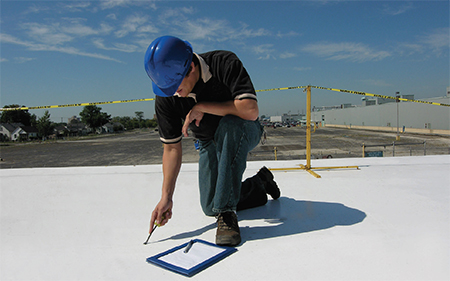Reflective Roofs and Urban Heat Islands

Photo courtesy of Duro-Last
Installing a Reflective Roof: How to Maximize the Benefits
After selecting the best reflective roof for any application, it is also important to maximize the benefits of the roof by minimizing the potential for degradation of the reflective surface finish. In order to achieve an optimal level of reflectivity over the service life of the roof, several strategies should be employed, both during installation and over the service life of the roof.
During Installation
The key to maximizing long-term reflectivity during installation involves minimizing the effects of roof traffic. All roofing crew members should wear clean, non-marring shoes, and all construction debris should be removed promptly. Because each and every installation activity may increase the potential for surface degradation, the building designer or installer should consider the use of a pre-assembled roofing membrane that reduces both the time required for installation and the potential to mar the surface during installation.
During Use
Just as during installation, the key to maximizing long-term reflectivity during use also involves limiting the effects of roof traffic. To accomplish this, access to the roof should be controlled and limited only to qualified maintenance personnel. And just like the original roofing crew, all maintenance personnel should wear clean, non-marring shoes. Finally, the roof surface should be inspected after storms for damage, and all roof drains should be maintained free of debris that could allow water to accumulate and discolor the roof surface.
For More Information
For the building owner or designer looking to install a reflective roof in the near future, this article should serve as a useful starting point. However, additional information providing a more in-depth look at the issues raised in this article also may be useful. The following documents, all freely available via the internet, are recommended for an expanded understanding of heat islands and the benefits of reflective roofing:
- EPA Heat Island Home (http://www.epa.gov/heatisland/index.htm). The U.S. Environmental Protection Agency offers a comprehensive overview of the dynamics of urban heat islands and the role that reflective roofs can play in mitigating their effects.
- LBL Heat Island Group (https://heatisland.lbl.gov/). Much of the research work conducted on heat islands by Lawrence Berkeley National Laboratory is available at this site.
- Global Cool Cities Alliance (http://www.globalcoolcities.org/ ). The Global Cool Cities Alliance (GCCA) was launched in 2010 to accelerate a worldwide transition to cooler, healthier cities. Its website offers extensive information about urban heat islands and how cool roofs and cool pavements can help. Especially useful is the GCCA’s Cool Roof and Cool Pavement Tool Kit (http://www.coolrooftoolkit.org/readthe-guide/).
- Recent Articles. Several articles recently published in Architectural Roofing & Waterproofing/WC Architect
- Reducing Peak Energy Demand: A Hidden Benefit of Cool Roofs. This article, published in the Spring 2015 edition, provides a detailed review of the peak demand charges currently applied to commercial utility bills and how the use of reflective roofs can reduce these costs. http://www.arwarchitect.com/articles/85002-reducing-peak-electrical-demandhidden-benefit-of-cool-roofs
- Roofs and Condensation: A Practical Approach for the Design Professional. This article, published in the Summer 2015 edition, provides a comprehensive review of the issue of condensation and reflective roofs and offers detailed recommendations for the building designer to avoid the potential for roof condensation in the design and installation of any roofing system. http://www.arwarchitect.com/articles/85187-roofs-and-condensation
Endnotes
- U.S. Environmental Protection Agency (2015). What is an urban heat island? Available: http://www.epa.gov/hiri/about/index.htm
- Akbari, H. (2005). Energy saving potentials and air quality benefits of urban heat island mitigation. Lawrence Berkeley National Laboratory. Available: http://www.osti.gov/scitech/servlets/purl/860475
- U.S. Environmental Protection Agency. Available: http://www.epa.gov/hiri/images/UHI_profilerev-big.gif
- Wikipedia (2015). Earth’s energy budget. Available: http://en.wikipedia.org/wiki/Earth%27s_energy_budget
- Hoff, J. (2015). Reducing peak energy demand: A hidden benefit of cool roofs. Architectural Roofing & Waterproofing/ WC Architect, Spring 2015. Available: http://www.arwarchitect.com/articles/85002-reducing-peakelectrical-demand-hidden-benefit-of-cool-roofs
- Akbari, H., Rosenfeld, A., &Menon. S. (2009). Global cooling: Increasing world-wide urban albedos to offset CO2. Climatic Change 94 (3-4), 275-286. Slides available: http://www.climatechange.ca.gov/events/2008_conference/presentations/2008-09-09/Hashem_Akbari.pdf
- Green Roofs for Healthy Cities (2014 ) . 2013 Annual green roof industry survey. Available: http://www.greenroofs.org/resources/GreenRoofIndustrySurveyReport2013.pdf
- Tegnos Research, Inc. (2011). Low-slope commercial roofing 2000-2010. Available: http://tegnos.org/files/2001to2010Market_Report.pdf
- Graham, M. S., & Dupuis, R. M. (2005). Cooling down Chicago: Chicago's attempt to reduce its heat island results in interesting research findings. Professional Roofing, December. Available: http://www.professionalroofing.net/Articles/Cooling-down-Chicago--12-01-2005/764
- Nunez, M; T. R. Oke (1977). The Energy Balance of an Urban Canyon. Journal of Applied Meteorology, 16: 11–19. Available: http://journals.ametsoc.org/doi/abs/10.1175/1520-0450%281977%29016%3C0011%3ATEBOAU%3E2.0.CO%3B2
- Graph and data adapted from A Practical Guide to Cool Roofs and Cool Pavements, published by the Global Cool Cities Alliance. Available: http://www.coolrooftoolkit.org/read-the-guide/
- Rosenfeld, A. H., Akbari, H., Romm, J.J., & Pomerantz, M. (1998) Cool communities: Strategies for Heat Island Mitigation and Smog Reduction, Energy and Buildings, 28, 1
- U. S. Department of Energy (2010). Guidelines for Selecting Cool Roofs. Available : https://heatisland.lbl.gov/sites/all/files/coolroofguide_0.pdf
- Editor (2008). Pausing for reflection on aging of the cool roof. Journal of Architectural Coatings, June/July.
- A summary of recent research involving reflective roofs and adjacent surfaces is included in Section 3.2 of Unintended Consequences : A Research Synthesis Examining the Use of Reflective Pavements to Mitigate the Urban Heat Island Effect, published by the National Center of Excellence for Smart Innovations, Arizona State University. Available: https://ncesmart.asu.edu/docs/smart/unintended-consequences-1013.pdf
- Hoff, J. (2015). Roofs and condensation: A Practical Approach for the Design Professional. Architectural Roofing & Waterproofing/WC Architect , Summer 2015. Available: http://www.arwarchitect.com/articles/85187-roofs-and-condensation
Subscribe to Architectural Roofing & Waterproofing / Walls & Ceiling Architect
Known as the “World’s Best Roof®,” a Duro-Last® roof is perfect for any flat, low-sloped, new or retrofit application. Precision-fabricated accessories combined with prefabricated deck sheets or roll goods allow for a watertight roof that doesn’t sacrifice aesthetics. www.duro-last.com |








